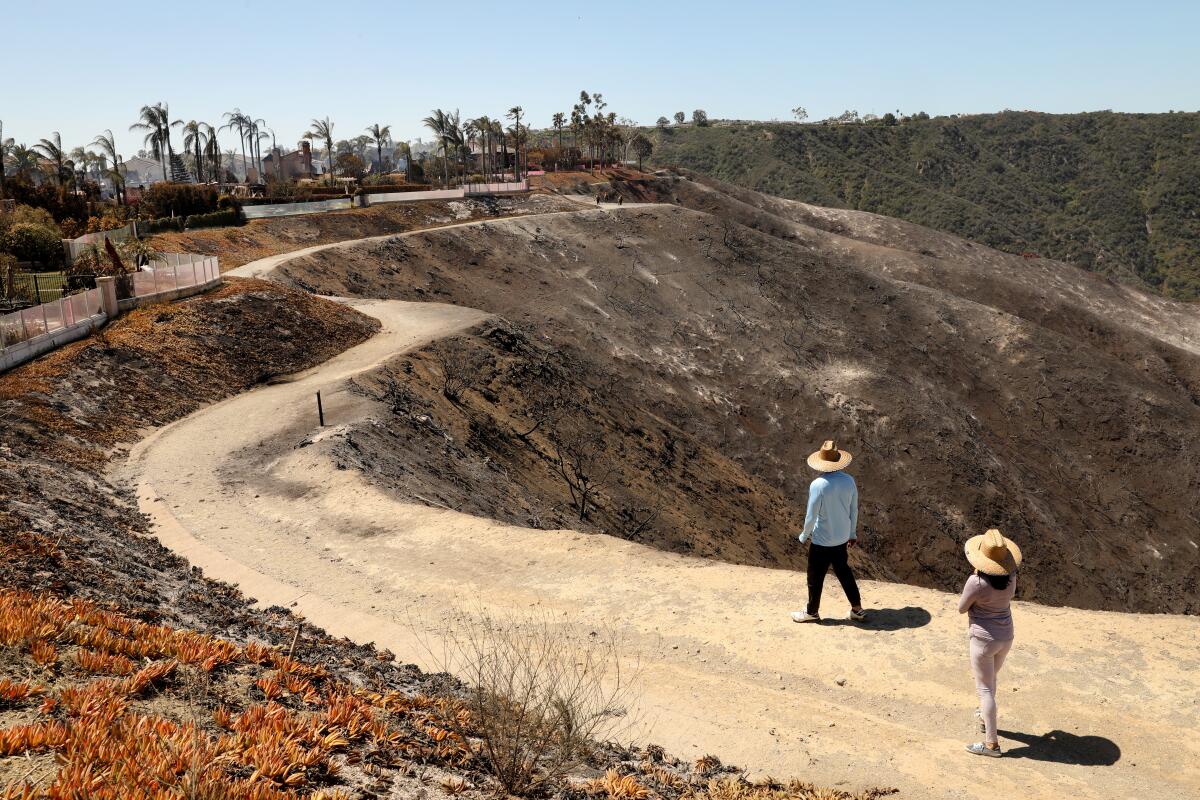Letters to the Editor: Where fire experts have told us for decades not to build

- Share via
To the editor: In May 2022, some residents of Laguna Niguel lost their homes in the Coastal fire, which started in Aliso Canyon. It was as if they had witnessed a rerun of the L.A. Fire Department’s film about the 1961 Bel-Air fire, “Design for Disaster,” cited in Jenny Jarvie’s excellent article.
I first saw that film in the early 1970s at an Orange County Planning Commission hearing, where development was being considered for the ridgetops south of Aliso Canyon. A firefighter veteran of the Bel-Air inferno showed the film and pleaded with the commission to not approve development on the ridgetops.
He said this was the most dangerous place to put homes and warned of the “chimney effect,” where fires burning up slopes increase in height and danger.
His warning was ignored. Ridgetop development was approved.
Despite the promised 100-foot irrigated setback, the houses were built out to the edge. Thinning the vegetation on the slopes would supposedly reduce the fire danger, but it didn’t prevent losses from the Coastal fire. Even a fire access road below the homes made no difference. The chimney effect pushed flying embers into the air, setting houses along the edge ablaze.
Developers made a lot of money from having more lots to sell with better views. The buyers, unaware of the warnings and voided protections, relied on the government to approve safe building sites. The homeowners paid a terrible price.
Political compromises with fire realities have proved tragic time after time.
Ann Christoph, Laguna Beach
The writer is a landscape architect and former mayor of Laguna Beach.
..
To the editor: Like they did in Santa Rosa after their disastrous wind-driven fire in 2017, you can rebuild with non-flammable home materials and succulents. But driving through Bel-Air and Brentwood recently — and it’s the same in many areas in SoCal — I noticed a plethora of palm, eucalyptus and pine trees that were dead or emaciated near homes.
With climate change increasing the likelihood of wind-driven fires, what is the solution to avert an almost certain disaster?
It’s an unimaginable, unrealistic goal to simply remove all of these trees. Simply having clearance around these homes is not enough when there is a wind-driven fire storm.
I wish I had a simple answer.
John Szabo, Newport Beach
..
To the editor: Please remind me why anyone thinks it is a good idea to encourage and promote the building of accessory dwelling units on properties in hillsides and canyons.
In my humble opinion, less density, not more, is what we need in these areas.
Emily Loughran, Los Angeles
..
To the editor: How many times have we heard that there is a homelessness problem that can be solved by building more homes?
We’re told that the problem is so acute that we need to fast-track the permitting process. Get rid of those pesky environmental reports, ignore fire regulations and get those homes built!
It’s not a “failure to learn.” Rather, it’s political expediency fueled by greed (or is it the other way around?).
Gregg Ferry, Carlsbad










